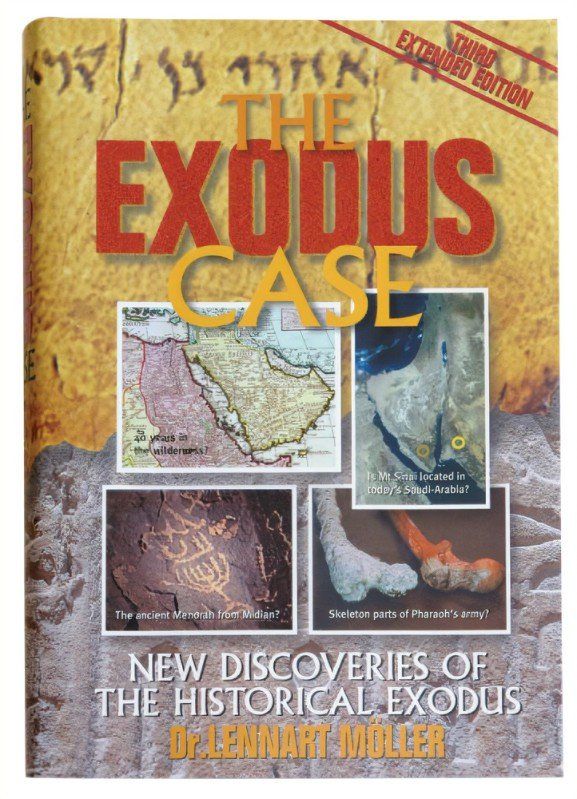The Real Mount Sinai in Saudi Arabia

THE MOUNTAIN TOP MELTED BY FIRE
The Bedouins call this mountain in ancient Midian, “Jebel el Lawz.” It stands there in stark contrast to the other mountains of the area because it is scorched black on the top. The Scriptures describe the time when Moses ascended to the top of the burning mountain to receive the Ten Commandments.
Blackened rocks cover the summit of Mt. Horeb where Moses met with God and the Ten Commandments were given. “And Mount Sinai was altogether in a smoke, because the LORD descended upon it in fire; and the smoke thereof ascended as the smoke of a furnace, and the whole mount quaked greatly.” Exodus 19:18
Explorer Ron Wyatt knew that locating the Red Sea crossing site was the first step in finding the real Mount Sinai. In 1984, after he had found evidence of underwater chariot wheels off Nuweiba Beach, forty miles south of Eilat, Israel, Wyatt and his two sons entered Saudi Arabia. They discovered that the upper 200 feet of Jebel el Lawz is burned black, as pictured above.
STONE COLUMNS MARK THE SPOT:
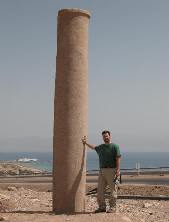
Two stone columns erected by Solomon: One of the columns was found in the water at Nuweiba Beach . . . the other on the shore of Saudi Arabia. Wyatt and his sons were apprehended by Saudi government officials and were accused of being spies. They were held prisoner for two months awaiting execution. After Ron helped to heal many sick prisoners, the authorities listened to his story and accompanied him to the column at the Saudi beach, then to Mt. Sinai. It was then that they believed his story and released him. But they confiscated his photographs before letting him and his sons go. U.S. Government satellite photos and a few private photos smuggled out of the country reveal the secret mountain by its unique blackened peak.
When Wyatt visited the site again a year later, a Saudi archaeologist accompanied him and discovered that the Saudi government had erected a fence and a guard house, preventing access to the mountain on the eastern side. The sign stated, “Archaeological area…unlawful to trespass, subject to penalty.”
The real Mt. Sinai: Unlike the traditional site in the Sinai Peninsula, there are thousands of acres in which to encamp at the base of this mountain. Evidence abounds that this once was the encampment for many people. It should be noted here that there is absolutely no evidence of such an encampment or other artifacts at the traditional Mount Sinai located in the heart of the Sinai desert. Sometimes we assume things because someone makes a wild guess or writes a name on a map. The fact is, the real Mount Sinai is not in the Sinai Peninsula but "out of Egypt" in Saudi Arabia. The New Testament bears testimony of the real location of the mount as we read in Galatians 4:25 – “ . . . Mount Sinai is in Arabia . . . “
Rock altar where the Hebrews placed the golden calf: At the base of the mountain, Wyatt and the Saudi archeologist found a dozen giant boulders stacked in the encampment area. Twelve ancient Egyptian petroglyphs of bulls were clearly visible. It is believed the golden calf was placed upon these rocks. Large altars were also found on the east and west sides of the mountain. Twelve Egyptian pictographs are still very evident on the rocks thought to be the altar built for the pagan Golden Calf.
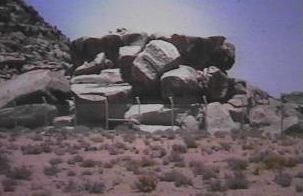

Split Rock of Horeb: On the western or back side of the mountain is Rephidim, where Moses and the Children of Israel first encamped before reaching Mt. Sinai. It was here that Moses struck the rock, above, which gushed forth large quantities of water. The giant 60 foot rock is on a 300 foot tall hill, and has obvious signs of water erosion, yet it is located in this extreme desert region. The split in the rock is so large that an adult can easily walk through it.
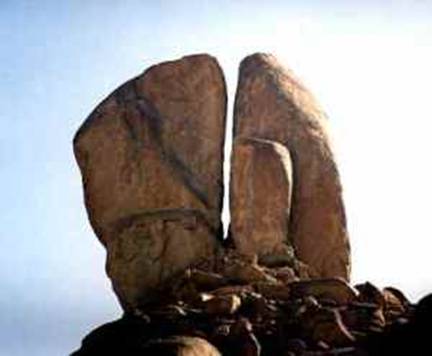
Altar of the golden calf at Mt. Horeb: The people built an altar unto the Golden Calf. Ancient inscriptions of the Egyptian calf are found on these rocks apparently in response to the words of Aaron — “These are thy gods, O Israel, which brought thee up out of the land of Egypt” Exodus 32:4
Petroglyph of the “calf gods” of Egypt. Heathen petroglyph worshipped by the Hebrews in Moses’ absence.
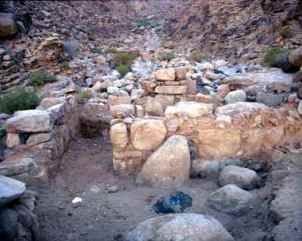
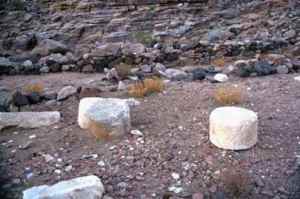
STONE ALTAR and COLUMNS: Pictured above are the remnants of the uncut stone altar where the priests sacrificed animals unto the Lord. This is located at the foot of the real Mt. Sinai in Saudi Arabia . . . ample evidence that the children of Israel once camped here as they received the Ten Commandments! Stone pillars at Mt. Sinai. Remnants of 12 stone pillars can also be found at the foot of Mount Sinai in Saudi Arabia. No such evidence has ever been found at the supposed site in the Sinai Peninsula in Egypt. A stone altar plus holding pens for animal sacrifices have been found at Mt. Sinai in Saudi Arabia. Stone holding pens have been found along with a stone altar and charred remnants of animal sacrifices.
Bible Texts Locate the Real Mount Sinai:
“Moses fled from the face of Pharaoh and dwelt in the land of Midian; and he sat down by a well” Ex. 2:15 NKJV. Maps indicate Midian is near the border of the Gulf of Aqaba in Northwest Saudi Arabia.
“And she [Zipporah] bore him a son, and he called his name Gershom; for he said, “I have been a stranger in a foreign land” Ex. 2:22. Moses was in a different country, away from any Egyptians in Saudi Arabia. He could not have been in the Sinai Peninsula, as that area was Egyptian controlled territory, full of Egyptian mines and communication towers. Moses would have been easily captured in that area.
“Now Moses kept the flock of Jethro his father-in-law, the priest of Midian. And he led the flock to the back of the desert, and came to Horeb, the mountain of God.” (Exodus 3:1) Jethro lived in the area near Mount Sinai. Jethro was the leader of the Midianites who were found in this area, “East of the Gulf of Aqaba in the northwestern regions of the Arabian Desert” (Britanica)
“So He [God] said, ‘I will certainly be with you. And this shall be a sign to you that I have sent you: When you have brought the people out of Egypt, you shall serve God on this mountain.” (Exodus 3:12) Moses was to bring the children of Israel out of Egypt to this same mountain in Midian, near Jethro’s home, in a foreign land.
“For this Hagar is Mount Sinai in Arabia . . . ” (Galatians 4:25) This passage clearly tells us where the mountain should be located, in Arabia. But where is Arabia? ” . . . it is bordered on the west by the Gulf of Aqaba and the Red Sea.” (Britanica)
“Then, at this saying, Moses fled and became a sojourner in the land of Midian, where he had two sons. And when forty years had passed, an Angel of the Lord appeared to him in a flame of fire in a bush, in the wilderness of Mount Sinai.” (Acts 7:29,30) All historically accurate maps, such as some produced by secular companies such as National Geographic, show Midian in Saudi Arabia. Unfortunately, maps placed in Bibles by the publishers may have Midian in the Sinai Peninsula in order to fit tradition, but not the Bible or the historical record.
Jewish Historian Josephus Said It Was the Highest Mountain:
Josephus said that Mt. Sinai “was the highest of mountains near the city of Midian” which is just outside the town of Al Bad. Jebel el Lawz is the highest mountain in the upper two thirds of the country. Also, Philo said Mt. Sinai was located east of the Sinai Peninsula and south of Palestine.
Imagine, if you and I were able to enter Saudi Arabia, we could visit the site where Moses and the Children of Israel encamped and were given the Ten Commandments! All of those remarkable events such as Pharaoh’s army being destroyed and Moses hitting the rock and water gushing forth are historically accurate as presented in the Bible!
The Exodus Case: A book has been written by Swedish scientist, Dr. Lennart Moller. He has extensively researched both the Red Sea crossing site and Jebel el Lawz firsthand. The book has over 550 color illustrations including topics of the real Mount Sinai, the Red Sea Crossing site at Nuweiba Beach, Sodom and Gomorrah, and Joseph’s grain storage complex in Egypt.
